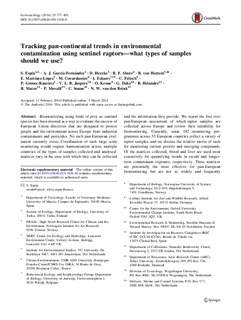| dc.contributor.author | Espín, Silvia | |
| dc.contributor.author | García-Fernández, Antonio J. | |
| dc.contributor.author | Herzke, Dorte | |
| dc.contributor.author | Shore, Richard F. | |
| dc.contributor.author | van Hattum, Bert | |
| dc.contributor.author | Martínez-López, Emma | |
| dc.contributor.author | Coeurdassier, Michael | |
| dc.contributor.author | Eulaers, Igor | |
| dc.contributor.author | Fritsch, Clémentine | |
| dc.contributor.author | Gómez-Ramírez, Pilar | |
| dc.contributor.author | Jaspers, Veerle | |
| dc.contributor.author | Krone, Oliver | |
| dc.contributor.author | Duke, Guy | |
| dc.contributor.author | Helander, Björn | |
| dc.contributor.author | Mateo, Rafael | |
| dc.contributor.author | Movalli, Paola | |
| dc.contributor.author | Sonne, Christian | |
| dc.contributor.author | van den Brink, Nico W. | |
| dc.date.accessioned | 2016-08-24T12:01:21Z | |
| dc.date.accessioned | 2016-08-30T08:36:26Z | |
| dc.date.available | 2016-08-24T12:01:21Z | |
| dc.date.available | 2016-08-30T08:36:26Z | |
| dc.date.issued | 2016 | |
| dc.identifier.citation | Ecotoxicology 2016, 25(4):777-801 | nb_NO |
| dc.identifier.issn | 0963-9292 | |
| dc.identifier.uri | http://hdl.handle.net/11250/2402667 | |
| dc.description.abstract | Biomonitoring using birds of prey as sentinel species has been mooted as a way to evaluate the success of European Union directives that are designed to protect people and the environment across Europe from industrial contaminants and pesticides. No such pan-European evaluation currently exists. Coordination of such large scale monitoring would require harmonisation across multiple countries of the types of samples collected and analysed-matrices vary in the ease with which they can be collected and the information they provide. We report the first ever pan-European assessment of which raptor samples are collected across Europe and review their suitability for biomonitoring. Currently, some 182 monitoring programmes across 33 European countries collect a variety of raptor samples, and we discuss the relative merits of each for monitoring current priority and emerging compounds. Of the matrices collected, blood and liver are used most extensively for quantifying trends in recent and longer-term contaminant exposure, respectively. These matrices are potentially the most effective for pan-European biomonitoring but are not so widely and frequently collected as others. We found that failed eggs and feathers are the most widely collected samples. Because of this ubiquity, they may provide the best opportunities for widescale biomonitoring, although neither is suitable for all compounds. We advocate piloting pan-European monitoring of selected priority compounds using these matrices and developing read-across approaches to accommodate any effects that trophic pathway and species differences in accumulation may have on our ability to track environmental trends in contaminants. | nb_NO |
| dc.language.iso | eng | nb_NO |
| dc.publisher | Springer Verlag | nb_NO |
| dc.rights.uri | https://creativecommons.org/licenses/by/4.0/ | |
| dc.subject | Bird of prey, Contaminant, Monitoring, Sample type, Matrix | nb_NO |
| dc.title | Tracking pan-continental trends in environmental contamination using sentinel raptors—what types of samples should we use? | nb_NO |
| dc.type | Journal article | nb_NO |
| dc.type | Peer reviewed | nb_NO |
| dc.date.updated | 2016-08-24T12:01:20Z | |
| dc.source.pagenumber | 777-801 | nb_NO |
| dc.source.volume | 25 | nb_NO |
| dc.source.journal | Ecotoxicology | nb_NO |
| dc.source.issue | 4 | nb_NO |
| dc.identifier.doi | 10.1007/s10646-016-1636-8 | |
| dc.identifier.cristin | 1366235 | |
| dc.description.localcode | © The Author(s) 2016 - Open Access This article is distributed under the terms of the Creative Commons Attribution 4.0 International License (http://creativecommons.org/licenses/by/4.0/), which permits unrestricted use, distribution, and reproduction in any medium, provided you give appropriate credit to the original author(s) and the source, provide a link to the Creative Commons license, and indicate if changes were made. | nb_NO |

